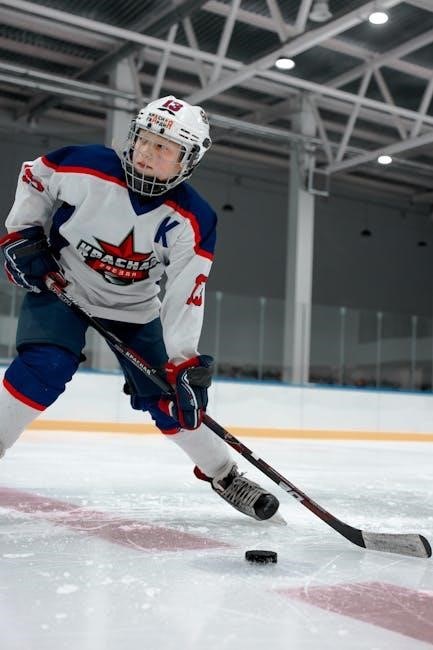Proper hockey skate sizing is crucial for performance and comfort. Skates typically fit 1-1.5 sizes smaller than street shoes, ensuring a snug, responsive fit for optimal skating.
Understanding the Importance of Proper Fit
A proper fit in hockey skates is essential for both performance and comfort. Skates that are too tight can restrict movement and cause discomfort, while skates that are too loose may lead to blisters and reduced control on the ice. A snug fit ensures better responsiveness and stability, allowing players to skate more efficiently. Properly fitted skates also help prevent injuries by providing adequate support and minimizing foot movement within the boot. Additionally, a good fit enhances accuracy and power during strides and turns, making it a critical factor in a player’s overall performance. Ensuring the right fit is a cornerstone of enjoying and excelling in the sport.

How Hockey Skate Sizing Works
Hockey skate sizing involves converting shoe size to skate size, with seniors sizing down 1.5 sizes and juniors/youth sizing down 1.0. Proper fit ensures optimal performance and comfort.
Differences Between Senior, Junior, and Youth Skates
Senior, junior, and youth hockey skates differ in size, fit, and design. Senior skates are for adults, fitting 1.5 sizes smaller than street shoes, while juniors and youths fit 1.0 size down. The width and support also vary, with seniors offering a more snug fit and juniors/youths providing a slightly roomier toe box for growth. Blade stiffness increases with senior skates for better performance, whereas junior and youth skates are softer, making them easier to handle for younger players. These distinctions ensure each age group gets optimal support, comfort, and performance tailored to their needs and skill levels.
Measuring Foot Length for Accurate Sizing
Accurate foot length measurement is essential for proper hockey skate sizing. Place your foot flat on the ground, heel against a wall, and measure from the back of the heel to the tip of the longest toe. Use a ruler or a shoe size chart for precision. Stand in a weight-bearing position to ensure an accurate reading. Keep the foot straight and avoid bending, as this can distort the measurement. Measure both feet, as they may differ slightly, and use the longer foot for sizing. Convert the measurement to the Mondopoint system or use a brand-specific chart for the best fit. This ensures your skates align with your foot length, providing optimal comfort and performance.
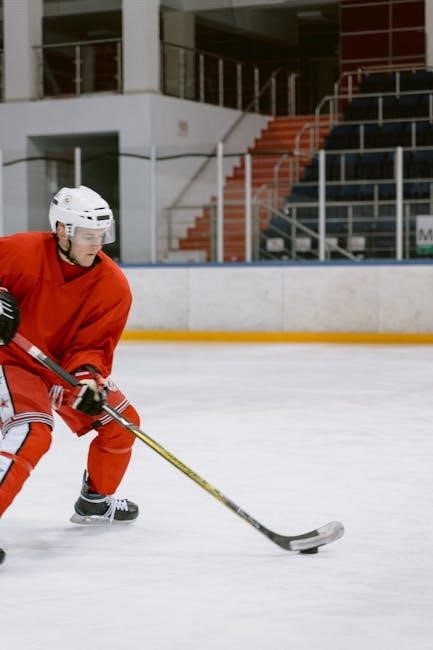
Senior Skate Sizing Guide
Senior hockey skates typically fit 1.5 sizes smaller than street shoes. Use a size chart to match foot length with skate size for optimal performance and comfort.
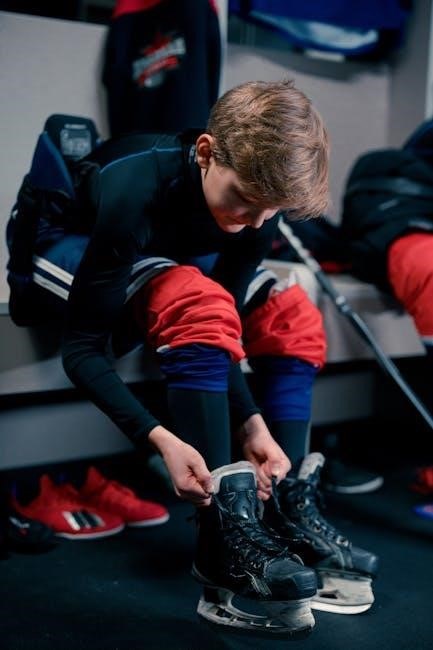
Converting Shoe Size to Senior Skate Size
Senior hockey skates typically fit 1.5 sizes smaller than street shoes. To convert your shoe size to a senior skate size, subtract 1.5 from your standard shoe size. For example, if you wear a size 9 shoe, you would look for a senior skate size 7.5. This sizing difference ensures a snug, responsive fit essential for optimal performance. Always refer to a brand-specific size chart, as sizing can vary slightly between manufacturers. Proper fit is critical, so measure your foot length and consider personal comfort preferences when making your final selection.
Understanding Senior Skate Fit Criteria
A proper senior skate fit should feel snug but not overly tight, with toes barely touching the toe cap and no more than 1/4 inch of space in the heel. The foot should rest flat on the footbed, and the skates should feel responsive. When laced, the skates should provide even pressure without restricting movement. Senior skates are designed to fit 1.5 sizes smaller than street shoes, ensuring optimal performance and comfort. Personal comfort preferences may vary, so it’s important to try on skates with the same type of socks you’ll wear during play. Proper fit is essential for both performance and injury prevention.

Junior and Youth Skate Sizing Guide
Junior and youth skates fit 1 size smaller than street shoes, ensuring a snug, comfortable fit for growing feet while maintaining performance and support.
Converting Shoe Size to Junior/Youth Skate Size
Converting shoe size to junior or youth skate size involves sizing down by one from your street shoe size. For example, if your child wears a US shoe size 10, they would typically fit into a junior/youth skate size 9. This adjustment ensures a snug fit, which is essential for proper support and performance on the ice. When measuring, consider the length and width of the foot to avoid any discomfort or restricted movement. Always refer to brand-specific sizing charts, as minor variations may exist between manufacturers. Proper fit enhances skating efficiency and overall comfort, making it crucial for young players to find the right size. Additionally, wearing the correct thickness of socks can impact the fit, so ensure they match what will be worn during games or practices.
Understanding Junior/Youth Skate Fit Criteria
A proper fit for junior and youth hockey skates is essential for comfort, support, and performance. Skates should fit snugly, with toes barely touching the toe cap and minimal heel movement. Unlike senior skates, junior and youth sizes are designed with growing feet in mind, offering a slightly roomier fit to accommodate growth while maintaining support. The boot should feel firm but not restrictive, allowing for proper ankle movement. It’s important to consider foot width, as narrower feet may require a different skate width. Parents should ensure their child can stand and skate comfortably without pressure points. Proper fit enhances skating efficiency and reduces the risk of discomfort or injury, making it vital to test skates with the same socks worn during play. Regular checks for fit are recommended as feet grow. Brands often provide size charts tailored for juniors and youths, ensuring accurate measurements and optimal performance. Always prioritize comfort and support to help young players enjoy the game. Correct fit criteria are crucial for skill development and overall skating experience.
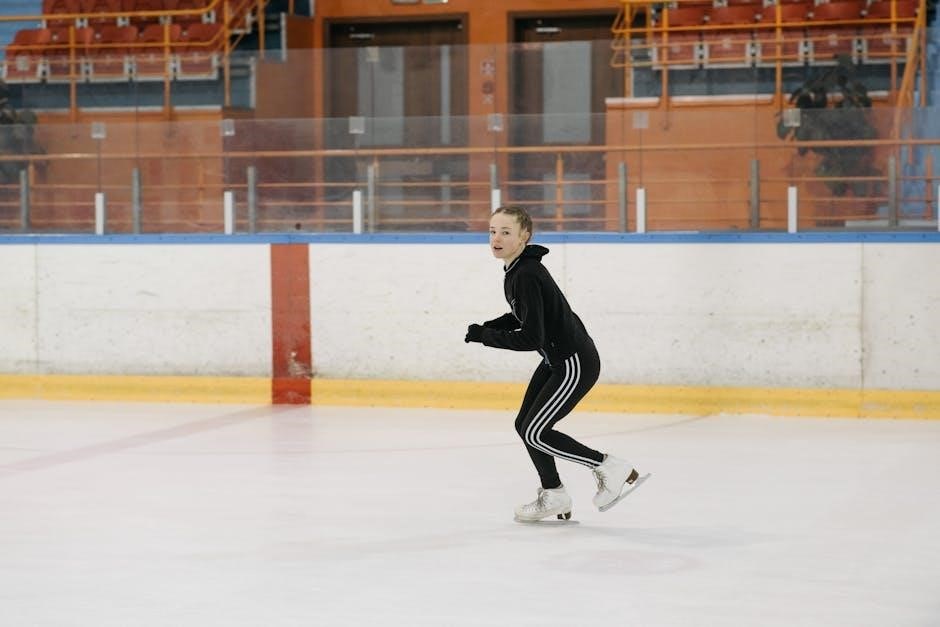
Importance of Skate Width and Comfort
Skate width significantly impacts performance and comfort. Proper width ensures snug support, reducing discomfort and enhancing skating efficiency. Narrow skates can cause pressure, while wider skates may feel too roomy.
How Skate Width Affects Performance
Skate width plays a pivotal role in performance, as proper fit ensures optimal support and maneuverability. A skate that is too narrow can cause discomfort and restrict movement, while a skate that is too wide may lack responsiveness. Narrow skates are ideal for players with slim feet, offering a snug fit that enhances agility and control. Wider skates, on the other hand, are better suited for those with broader feet, providing necessary support without sacrificing performance. The right width ensures even pressure distribution, reducing fatigue and improving skating efficiency. Choosing the correct width is essential for maximizing speed, stability, and overall performance on the ice.
Choosing the Right Skate Width for Your Foot
Selecting the correct skate width is essential for comfort and performance. Measure your foot’s width to determine if a narrow, medium, or wide skate is appropriate. Narrow widths suit slim feet, providing a snug fit that maximizes agility. Medium widths offer a balanced fit, ideal for most players. Wide skates accommodate broader feet, ensuring proper support without constriction. Consider brand-specific width options, as some brands cater to specific foot shapes. Trying skates on with hockey socks helps ensure accurate sizing. Proper width prevents blisters, enhances stability, and allows for effective power transfer during skating. A well-fitting width optimizes performance, comfort, and overall skating efficiency for players of all levels.
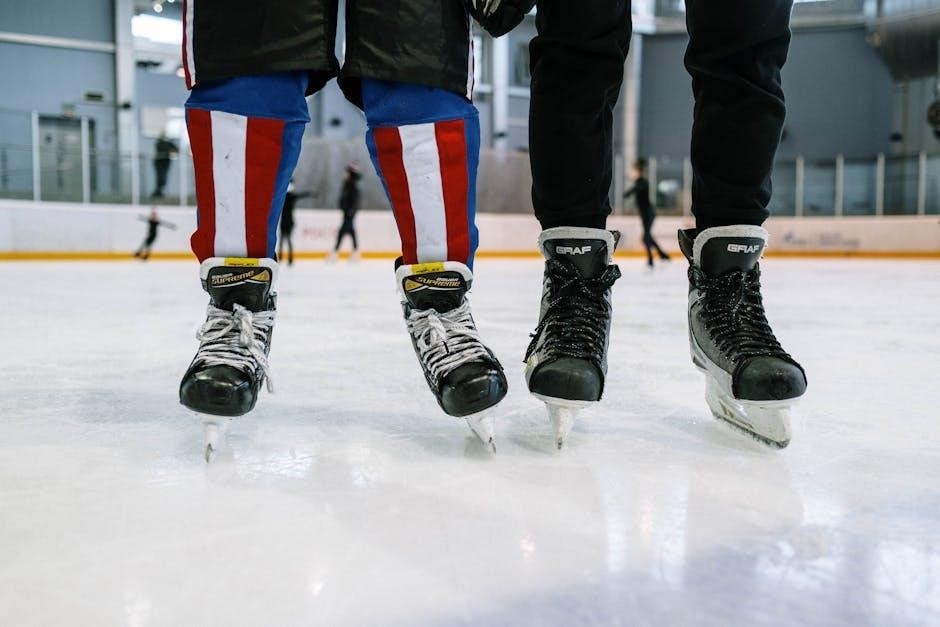
Brand-Specific Hockey Skate Sizing Charts
CCM, Bauer, and True Hockey offer detailed sizing charts, providing precise conversions and fit guides tailored to their unique skate designs and foot shapes for optimal performance.
CCM Skate Sizing Chart
CCM skate sizing charts provide detailed conversions for senior, junior, and youth skates. Sizes are listed in US, EU, and UK standards, along with Mondopoint measurements. For example, a size 7 junior skate corresponds to a US 8Y, EU 25, and Mondopoint 152. The chart also includes width options, such as D for standard widths. CCM skates are known for their tapered fit, ideal for narrow feet. When using the chart, ensure to measure foot length and compare it to the skate’s internal length. Proper fit is crucial for performance and comfort. Always refer to CCM’s official sizing guide for accurate measurements and optimal fit.
Bauer Skate Sizing Chart
Bauer skate sizing charts offer precise measurements for senior, junior, and youth skates. The chart includes US, EU, and UK sizes, along with Mondopoint (cm) measurements. For example, a Bauer size 7 junior corresponds to a US 8Y, EU 25, and Mondopoint 152. Bauer skates are known for their anatomical fit, catering to different foot shapes. The Vapor line features a tapered fit, while the Supreme line offers a fuller fit. When using the chart, ensure to measure foot length accurately and compare it to the skate’s internal length. Proper fit is essential for both performance and comfort. Always refer to Bauer’s official sizing guide for the best results.
True Hockey Skate Sizing Chart
True Hockey skate sizing charts provide detailed measurements for accurate fit. They cater to various foot shapes and preferences, ensuring comfort and performance. The chart includes US, EU, and Mondopoint sizes, with precise foot length correlations. For example, a size 7 in True Hockey skates corresponds to a 24.5 cm foot length. The brand emphasizes a snug, responsive fit, with sizes typically running 1-1.5 smaller than street shoes. True Hockey offers a tapered fit for slim feet and a wider fit for broader feet. Always measure foot length accurately and refer to the official True Hockey sizing guide for the best fit. Proper sizing ensures optimal skating performance and comfort.
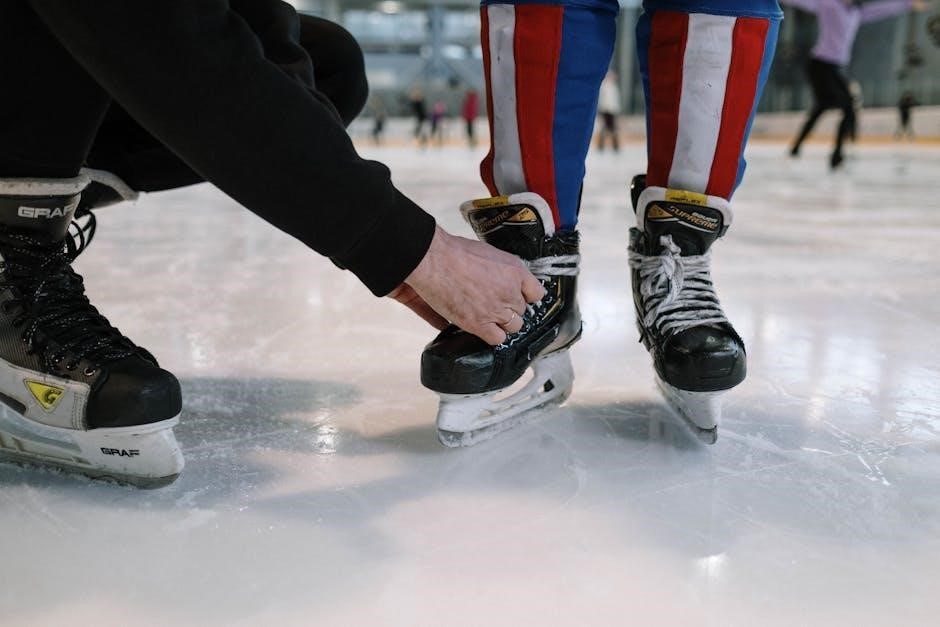
Common Mistakes to Avoid When Sizing Hockey Skates
Avoiding common mistakes ensures a perfect fit. Not considering foot width and ignoring personal comfort preferences are frequent errors. Proper sizing enhances performance and comfort significantly.
Not Considering Foot Width
Ignoring foot width is a common mistake when sizing hockey skates. A narrow or wide foot may require a different skate width for optimal fit. Skates come in various widths, such as standard, narrow, or wide, to accommodate different foot shapes. Failing to consider width can lead to discomfort, reduced performance, or even blisters. To ensure the best fit, measure both foot length and width. Use brand-specific sizing charts, which often include width options, to find skates that match your foot dimensions. Proper width ensures better support, stability, and mobility on the ice, enhancing overall skating experience and performance.
Ignoring Personal Comfort Preferences
Overlooking personal comfort preferences can lead to poor skate fit and hinder performance. While sizing charts provide a guide, individual comfort varies. Some players prefer a snug fit for responsiveness, while others need more room for comfort during long games. Ignoring these preferences can result in discomfort, blisters, or restricted movement. When trying on skates, ensure they feel comfortable while standing and skating. Consider factors like toe room, heel fit, and overall snugness. Prioritizing comfort ensures better skating efficiency and enjoyment. Always try skates on with the same socks worn during play and assess how they feel after lacing. Comfort is key to peak performance on the ice.
How to Try On Hockey Skates Properly
Sit comfortably, knees bent, and ensure skates fit snugly. Lace properly, stand to check balance, and walk to assess fit. Avoid tightness or discomfort.
Wearing the Right Socks
Choosing the right socks for hockey skates is essential for comfort and performance. Opt for thin, moisture-wicking socks made of breathable materials like wool or synthetic blends. These fibers help keep feet dry, reducing the risk of blisters and discomfort during play. Avoid thick or bulky socks, as they can restrict movement and cause friction inside the skate. Proper sock choice ensures a snug fit, allowing for better control and agility on the ice. Many players prefer socks specifically designed for hockey, as they provide additional cushioning and support in high-impact areas. Wearing the right socks enhances overall skating performance and comfort.
Checking for Proper Heel Fit
A proper heel fit is critical for stability and control in hockey skates. The heel should sit snugly in the boot without slipping or excessive pressure. When laced, the skates should hold the heel firmly, ensuring minimal movement. A well-fitted heel allows for efficient energy transfer during strides and turns. To check, press your heel into the back of the skate while standing upright; there should be no more than a quarter-inch of space. If the heel moves excessively, the skates may be too large. Proper heel fit prevents blisters and enhances skating performance by maintaining consistent contact with the boot.
Ensuring Toe Comfort
Toe comfort is essential for both performance and enjoyment in hockey. Properly fitted skates should allow your toes to barely touch the toe cap, with no more than 1/4 inch of space. This ensures optimal control and prevents discomfort. When trying on skates, wear the same socks you’ll use during games to gauge fit accurately. Lacing should be snug but not overly tight, as excessive pressure can cause discomfort. If your toes feel cramped or there’s too much movement, the fit may be incorrect. Proper toe comfort enhances skating efficiency and reduces the risk of blisters or discomfort during extended play. Always prioritize a balance between snugness and freedom for your toes to ensure peak performance and comfort.
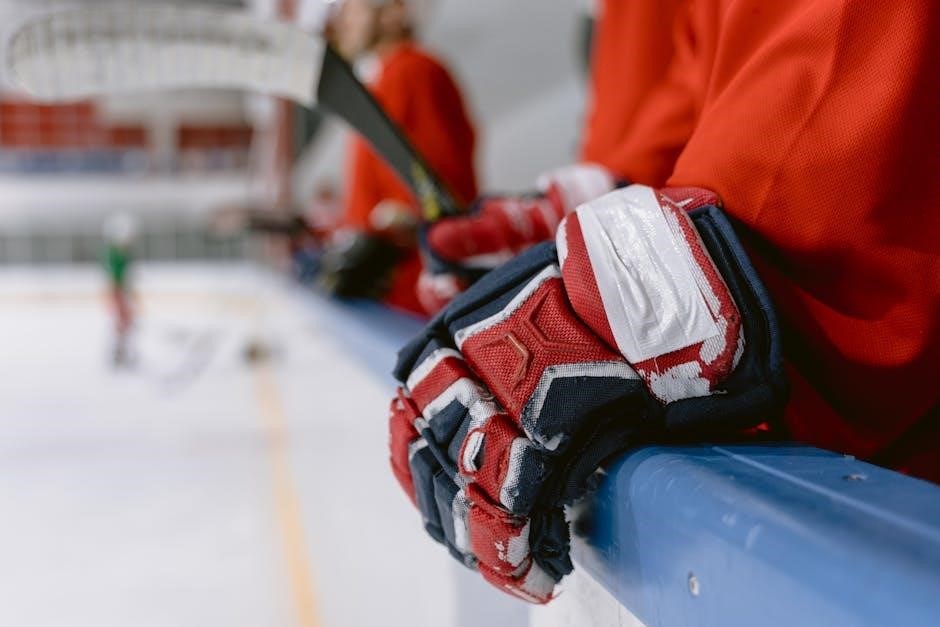
Hockey Skate Sizing for Goalies
Goalie skates require a unique fit, prioritizing support and stability. They often feature a more rigid structure and longer blade for better performance in the crease.
Unique Fit Requirements for Goalie Skates
Goalie skates have distinct fit requirements due to their specialized role. Unlike player skates, goalie skates are built with a more rigid boot and a longer, flatter blade for stability and maneuverability.
- The boot is typically taller and more supportive to accommodate the unique movements of goaltending.
- The longer blade provides better balance and reach, essential for covering the crease.
- Fit needs to balance snugness for support while allowing enough mobility for quick reactions.
A proper fit ensures optimal performance, preventing discomfort or restricted movement during games.
How to Choose the Right Size for Goalie Skates
Choosing the right size for goalie skates involves measuring foot length and comparing it to brand-specific sizing charts. Goalie skates typically fit 1-1.5 sizes smaller than street shoes.
- Measure the foot while wearing the same socks used during games for accuracy.
- Ensure the taller, more supportive boot fits snugly without restricting movement.
- Check that the heel is secure and the toes have minimal space to prevent sliding.
A proper fit ensures stability, mobility, and comfort, essential for a goalie’s performance.
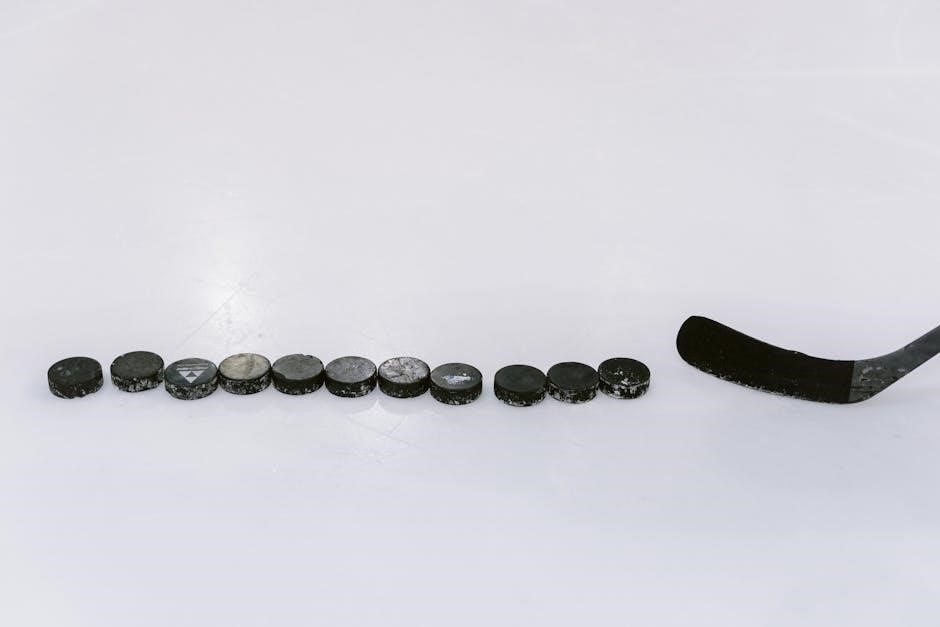
How to Care for Your Hockey Skates
Proper maintenance ensures longevity and performance. Dry skates thoroughly after use, sharpen blades regularly, and store in a cool, dry place to prevent damage and odor.
Importance of Skate Maintenance
Regular maintenance is essential for prolonging the life of hockey skates and ensuring optimal performance. After each use, skates should be thoroughly dried to prevent mold and bacteria growth. This includes removing the insoles and allowing the interior to air out. Sharpening the blades regularly maintains their edge, improving skating efficiency and control. Additionally, storing skates in a cool, dry place away from direct sunlight helps preserve the materials and structure. Proper care also involves inspecting for wear and tear, such as loose blades or cracked soles, which can affect fit and function. By maintaining your skates, you ensure durability, comfort, and peak performance.
How to Keep Your Skates Fitting Properly
To maintain the fit of your hockey skates, regular adjustments and care are necessary. Heat molding your skates can help customize the fit to your feet over time. Ensure you wear the same thickness of socks when skating as when you tried them on. Tighten the laces properly each time to prevent the skates from becoming too loose. Inspect the skates for wear and tear, such as stretched leather or damaged padding, which can affect the fit. If needed, replace insoles or have the skates professionally adjusted. Proper care ensures your skates remain comfortable and perform well throughout the season.
Proper hockey skate sizing is essential for performance and comfort. Ensure a snug fit by sizing down 1-1.5 sizes from street shoes and considering foot width for optimal skating.
Final Tips for Finding the Perfect Skate Size
Always measure your foot length and width for accurate sizing. Consider wearing the same socks you’ll use while skating to ensure a proper fit. Try skates on in the afternoon, as feet tend to swell during the day. Ensure your heel fits snugly and toes have minimal space. Don’t hesitate to ask for professional guidance at a hockey store. Remember, proper fit impacts performance, so take the time to get it right. Prioritize comfort and support to maximize your skating experience.
